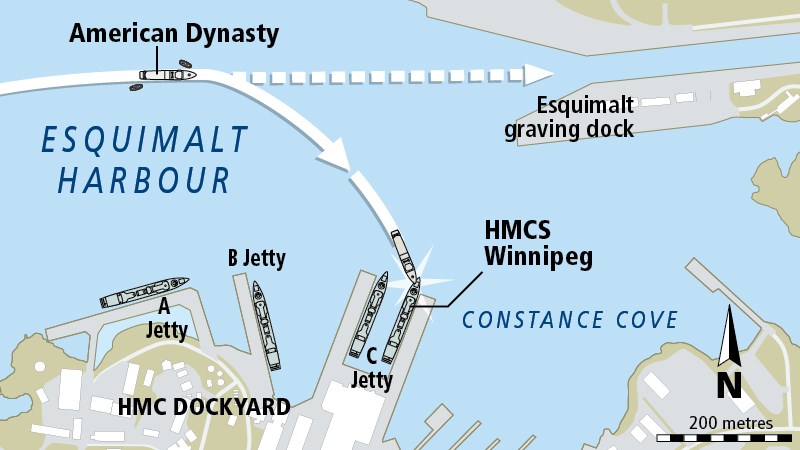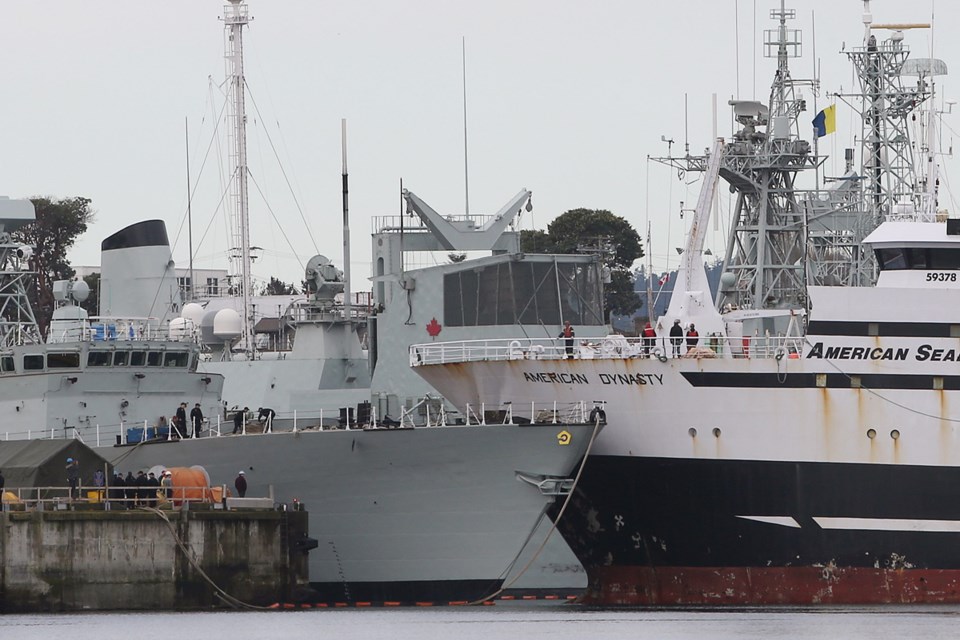An American fishing vessel ran into a docked HMCS Winnipeg in Esquimalt Harbour last spring because of a chaotic series of failures by crew and on-board equipment, the Transportation Safety Board of Canada has found.
The fishing vessel was heading into dry dock and didn’t have procedures to do so; it also didn’t have procedures to deal with equipment failure or manage emergencies during a power outage, the safety board said.
“It was lucky, very lucky” no one was seriously hurt, said Raymond Mathew, head investigator for marine investigations for the safety board’s Pacific region.
Six workers on HMCS Winnipeg suffered minor injuries in the collision, which caused extensive damage to both vessels.
American Dynasty, owned by American Seafoods Co., now has procedures and has repaired equipment to avoid a similar incident, the report said.
The collision occurred April 23, 2013, at 8:18 a.m. as American Dynasty was under the guidance of a docking pilot and being towed by two tugs into Esquimalt Harbour for repairs at the graving dock.
HMCS Winnipeg was tied up at a jetty at CFB Esquimalt.
The safety board investigation found chaos among crew on American Dynasty leading up to the collision.
At 8:15 a.m., the ship’s master switched off radars and telephoned the engine room. He advised the oiler, who answered the phone for the chief engineer — who was in the washroom — that he was transferring propulsion control to the engine room.
The oiler didn’t know how to accept the transfer, so he asked an electrician what he should do and was advised to push a transfer button on the propulsion control panel.
About 15 seconds after control was transferred, all electrical power on the vessel went out. An emergency generator did not start automatically.
Soon after, crew on the bridge noticed the vessel accelerating from 1.6 knots to 5.0 knots and turning to starboard, veering toward the Winnipeg.
The master tried to call the engine room but the phone was dead due to the electrical outage. The master then sent the first mate to the engine room to assess the situation.
The tugs pulling the fishing boat saw the change of course and tried to realign it by pulling it backward. One tug’s winch broke as American Dynasty pulled away.
Unaware of the increase in speed and change of direction, the chief engineer was working to restore power by focusing on breakers. Then the auxiliary generator engine shut down and the chief engineer left the engine room to find the cause.
On the bridge, the master ordered the vessel’s anchors be dropped, but in the seconds before impact, the plan was aborted. The master tried to sound a whistle but it didn’t function.
The two vessels were stuck together until 5:10 p.m., when American Dynasty was towed to Victoria Shipyards.
The investigation found that American Dynasty didn’t have procedures laid out for putting the vessel in dry dock or dealing with a blackout. The engine room didn’t identify ways to manage emergencies such as loss of power.
The reason for the blackout and for the vessel’s turn to starboard could not be determined.
It increased speed because the power outage pushed fuel to the port engine. Without electrical power, an alarm for the increase of power didn’t go off and alert the crew.
“Crew members who have not been adequately familiarized with a vessel and its equipment may not have the knowledge necessary to perform their duties,” the report said.
“Furthermore, without procedures and comprehensive drills for emergency situations, crew may not be proficient in taking mitigating action during an emergency.”




